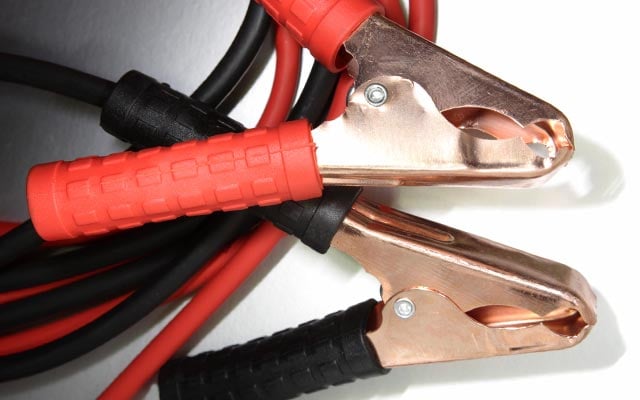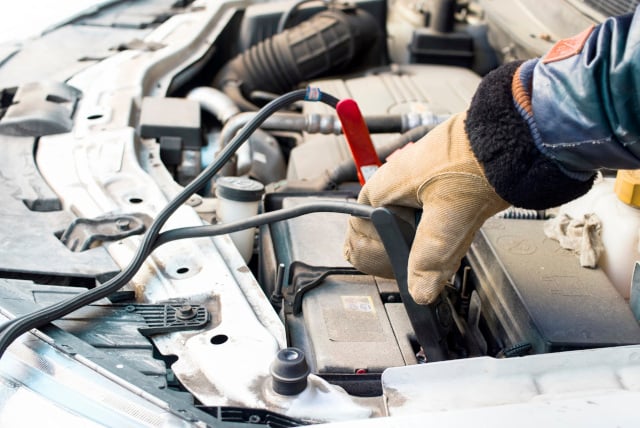A jump start is a handy way to start a car with a flat battery. But jump leads can cause damage to both cars and people if they’re not used properly.
For your safety, and our peace of mind, we’d always prefer you to give us a call and leave the jump starting to our trained mechanics.
If you’re keen to do it yourself, take a look at our advice on how to jump start a car. But make sure you read the instructions in your handbook and follow those if they're different to our steps.
If you have a dead battery, our Battery Assist team can replace a car battery on the same day.
In this article: |

What you'll need to jump start a car
If you're planning on carrying out a car battery jump start, you'll need the following:
- A pair of working jump leads (you can buy AA jump leads here)
- A pair of rubber work gloves (for safety)
- The vehicle with the flat battery, which needs to be in a spot where jump leads can easily reach the battery
- Another vehicle with a fully-charged battery (avoid a hybrid or electric car as this could cause damage)
| Back to top |
We provide 24/7 roadside assistance.
Using jump leads safely
Before you try to jump start a car or learn how to attach jump leads, remember that batteries produce flammable gases. Here's how to stay safe:
Check the battery and jump leads
- Never try to jump start a battery that looks damaged or is leaking
- Don’t use jump leads that are damaged
- Stop using the jump leads if they get hot
Make sure the environment is safe
- Before you start, remove any dangling clothing – like a scarf or tie – as it could get caught up in the moving engine parts
- Don’t let any metal objects touch the car batteries - these could cause a spark and possibly make the battery explode. That includes rings, necklaces, watch straps, hand tools, clips, stray wires etc.
- Never smoke or allow naked flames anywhere near either battery
Take care removing the jump leads
- Don't remove the jump leads while the car engines are running. This can cause serious damage to the cars’ electronics
| Back to top |
A step-by-step guide to jump starting a car
If you want to jump start a car with cables, then you'll need to find someone with a car who’s happy to help. Their car must have a fully charged battery with the same voltage as yours (usually 12 volts).
1. Line up both cars
- Park both cars so their batteries are within easy reach of one another (without the cars actually touching)
- Keep the handbrakes on and the ignitions off
2. Connect the red jump lead
- Use the red jump lead to connect the working battery’s positive (+) terminal to the flat battery’s positive (+) terminal. Never touch the ends of the red and black leads together as this could create sparks and cause vehicle damage
3. Connect the black jump lead
- Take the black jump lead and attach it to the negative (-) terminal on the working battery
- Then attach the other end to an earthing point (unpainted metal on the engine block or chassis) well away from the flat battery and fuel system
4. Start the other car
- Keep both engines off and wait for 3 minutes, then start the working car’s engine and let it run for 1 minute
5. Start your car
- Turn on the engine in the car with a flat battery
6. Let both cars run
- Leave both cars to idle, at a fast pace, for around 10 minutes
7. Turn off and disconnect
- Turn off both cars’ engines and carefully disconnect the leads in the reverse order to the way they were connected (remove the black lead from your car first and finish with the red lead from the other car)
- Make sure the leads don’t touch one another, or either car, as you remove them
8. Restart your car
- Try turning the keys in the ignition to see if your car will start up
9. Call for help
- If your car won’t start there’s probably a more serious problem requiring professional help
- If you’re still stuck, you can call us on 03330 046 046 or by using the AA app
- Get Instant breakdown cover
| Back to top |
How to remove the jump leads
You remove the jump leads in the reverse order to how you attached them. But if you're not sure, here are the steps:
- Switch off the engines on both vehicles
- Take the black jump lead off the earthing point
- Remove the other end of the black jump lead from the working battery's negative (-) terminal
- Disconnect the red jump lead from the working battery's positive (+) terminal
- Remove the other end of the red jump lead from the positive (+) terminal on the flat battery
While jump starting a car is a fairly straightforward procedure, it can carry potential risks, like shocking the user or causing damage to the vehicle's electrical systems if done incorrectly. So, bear this in mind if you're looking up how to jump start a car by yourself for the first time.
| Back to top |
What are jump leads?
Jump leads are a simple tool used to start up any vehicle with a flat battery. They feature four fully insulated alligator clips, two of which will attach to a vehicle with a working battery, while the other two clips will attach to the vehicle that needs its battery jump started.
There are two red clips and two black clips. One of each should be attached to each vehicle's battery. The red clip connects to a vehicle's positive (+) terminal, while the black clip connects to a vehicle's negative (-) terminal, vehicle chassis or engine block.
How do jump leads work?
Once connected correctly to two vehicles, jump leads work by sending extra power from the working vehicle's battery to the inactive vehicle's battery, providing enough temporary power to recharge the battery and start up the engine.
Is jump starting a car dangerous?
If a jump start is attempted in an unsafe manner then yes, it can be dangerous. One of the worst possible outcomes is that there could be an explosion (if you attempt to jump start a damaged or leaking vehicle battery).
In modern cars, jump starts can also lead to damage of key electrical systems on board the vehicle, including anything from the airbags to the Bluetooth systems. At worst using jump leads in the wrong way could harm you physically, and at best, it could cost you a fortune in vehicle repairs.
If in doubt, it's best to contact us to get help.
Is it possible to jump start a car in the rain?
Yes, it's possible to jump start a car in the rain, though it's not ideal. When jump starting a car it's best to keep everything under the bonnet dry and protected from water. Again, if in doubt, contact us and we can help.
How to jump start a car with a battery booster pack
It can be a good idea to keep a car battery booster pack in your car. That way, you can jump start your battery even if you can’t get another car to help you.
Before you start, make sure:
- The car battery doesn’t look damaged and isn’t leaking.
- You’ve taken off any metal jewellery or watches and removed dangling clothing like a tie or scarf.
Steps to using a car battery booster
1. Check the battery booster
- Make sure the pack's fully charged
- Put the battery booster pack somewhere stable. Don’t put it on the engine as it might fall off when the engine starts.
2. Connect the red jump lead
- Connect the red positive (+) jump lead from the battery pack to the positive (+) terminal of the car battery.
3. Connect the black jump lead
- Connect the black negative (-) jump lead to an earthing point on your car. Unpainted metal on the engine block or chassis is best.
4. Switch on the pack
- Once the battery pack's connected, switch on the pack.
5. Try to start the car
- Try to start your car by turning the key in the ignition.
- If it doesn’t start after a few tries, there’s probably a more serious problem that needs professional help. If you’re still stuck, you can call us on 03330 046 046 or use the AA app.
6. Let the engine run
- If the car starts, keep the engine running for about 5 minutes.
- After 5 minutes, switch off the boost pack and allow the engine to run for a further 5 to 10 minutes.
7. Turn off and disconnect
- Turn off the engine.
- Remove the leads in the reverse order to how you placed them on (first disconnect the black lead, then the red lead).
8. Restart your car
- Try turning the keys in the ignition or pressing the start button to see if the car starts up again. You may also need to press the clutch to activate the starter system.
| Back to top |
What to do after you’ve jump started your car
If you’ve managed to jump start your car, the battery will need to recharge again fully.
- Charge the battery by driving normally (not in stop-start traffic) for at least 30 minutes.
- You can also use a portable car battery charger to top up the charge on your battery.
| Back to top |
How often should you change a car battery?
On average, batteries last between 5 and 7 years but you should only consider changing a car battery when it's showing signs of deterioration.
If the battery's more than 5 years old and seems like it's struggling to start the car, get it checked out. It's better to be safe than sorry - it'll be worse if it's a roadside emergency or on a cold morning when you're already late for work.
If you have breakdown cover with us, we'll come out to test your battery to see if it needs a charge or if you need a new one. You can find out more about breakdown cover with our guide.
| Back to top |
Can you jump start with a stop-start battery?
Jump starting a car with a stop-start battery is fine, though we would recommend to avoid using the battery's negative terminal. Always use a suitable earth point on an engine or chassis.
Does jump-starting a car damage the battery?
A successful jump start is unlikely to cause any damage (or additional damage) to either battery. A battery that's in good shape will continue to perform as usual and start recharging as you're driving. However, if the jump start is carried out incorrectly, it's possible to cause damage to a car battery.
Find out what your dashboard can tell you:
Last updated: 26 June 2024 | Author: The AA

